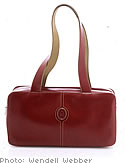To Have and to Hold—Neatly

Get your handbags, shoulder bags, and totes in order. Your goals will be to (1) carry only what you need, (2) be able to find everything quickly, and (3) switch from one bag to another with ease.
A bag is so much more than just a means of carting things from one place to another. It symbolizes our desire to contain and organize our lives, and sometimes it reflects what's working and what's not. If you're always carrying papers you never get around to dealing with, maybe you need to refocus your priorities. Taking time regularly to evaluate and clean out your bag will keep you feeling grounded and ready for whatever the day holds.
Stage 1: Jettison the Junk
Clean out your current bag over a trashcan. Brace yourself for what you might find: shredded tissues, nearly empty tubes of cream, old shopping lists, nameless phone numbers, forgotten vitamins, and grit-covered gum. Toss obvious trash, and sort whatever remains into two piles—"permanent" and "transient." The permanent pile should include things you need every day: keys, wallet, eyeglasses, cell phone, planner, pens, notepad, business cards, and basic makeup. The transient pile consists of anything you need just for the day: a shopping list, a newspaper, bills to pay, items for repair, etc. Now pare down each pile to the essentials. I have found that most people use only about 20 percent of what they carry, so be brutal—you can keep backup supplies in your car or desk drawer. Set personal weight limits, and think twice about carrying hardcover books. Don't take home work files unless you've scheduled a specific time to tackle them.
Stage 2: Get the Right Bag
Consider these questions:
Take a look at this transformation with the help of a purseket!
Keep in mind: A colored rather than black lining helps you find your stuff more quickly; a bag that's wider than it is deep is easier to get in and out of; and your purse should be big enough for everything you need without having to cram things in.
Stage 3: Compartmentalize
Organize your bag into zones—for example, put money in one zippered pocket, makeup in another, communication tools such as a cell phone and planner in an easily accessible space, and reading material in another section. If you follow the same pattern with each bag, you'll be able to locate items with your eyes closed.
Stage 4: Commit to a daily routine of unpacking and reloading
Store spare bags on hooks or all together on one shelf, and establish a nearby drawer for extra wallets, credit and ID cards, and travel-size toiletries.
A bag is so much more than just a means of carting things from one place to another. It symbolizes our desire to contain and organize our lives, and sometimes it reflects what's working and what's not. If you're always carrying papers you never get around to dealing with, maybe you need to refocus your priorities. Taking time regularly to evaluate and clean out your bag will keep you feeling grounded and ready for whatever the day holds.
Stage 1: Jettison the Junk
Clean out your current bag over a trashcan. Brace yourself for what you might find: shredded tissues, nearly empty tubes of cream, old shopping lists, nameless phone numbers, forgotten vitamins, and grit-covered gum. Toss obvious trash, and sort whatever remains into two piles—"permanent" and "transient." The permanent pile should include things you need every day: keys, wallet, eyeglasses, cell phone, planner, pens, notepad, business cards, and basic makeup. The transient pile consists of anything you need just for the day: a shopping list, a newspaper, bills to pay, items for repair, etc. Now pare down each pile to the essentials. I have found that most people use only about 20 percent of what they carry, so be brutal—you can keep backup supplies in your car or desk drawer. Set personal weight limits, and think twice about carrying hardcover books. Don't take home work files unless you've scheduled a specific time to tackle them.
Stage 2: Get the Right Bag
Consider these questions:
- Do you like carrying one bag for everything, or a small purse plus a tote or briefcase?
- Are you most comfortable with a shoulder bag, backpack, or handheld bag?
- Do you fare better with lots of little compartments or a large open section? I find that totes need subdivision to prevent chaos. Zippered pouches or clever products called Pursekets, (www.purseket.com) which provide pockets and can be moved from bag to bag, are good solutions.
Take a look at this transformation with the help of a purseket!
Keep in mind: A colored rather than black lining helps you find your stuff more quickly; a bag that's wider than it is deep is easier to get in and out of; and your purse should be big enough for everything you need without having to cram things in.
Stage 3: Compartmentalize
Organize your bag into zones—for example, put money in one zippered pocket, makeup in another, communication tools such as a cell phone and planner in an easily accessible space, and reading material in another section. If you follow the same pattern with each bag, you'll be able to locate items with your eyes closed.
Stage 4: Commit to a daily routine of unpacking and reloading
Store spare bags on hooks or all together on one shelf, and establish a nearby drawer for extra wallets, credit and ID cards, and travel-size toiletries.



